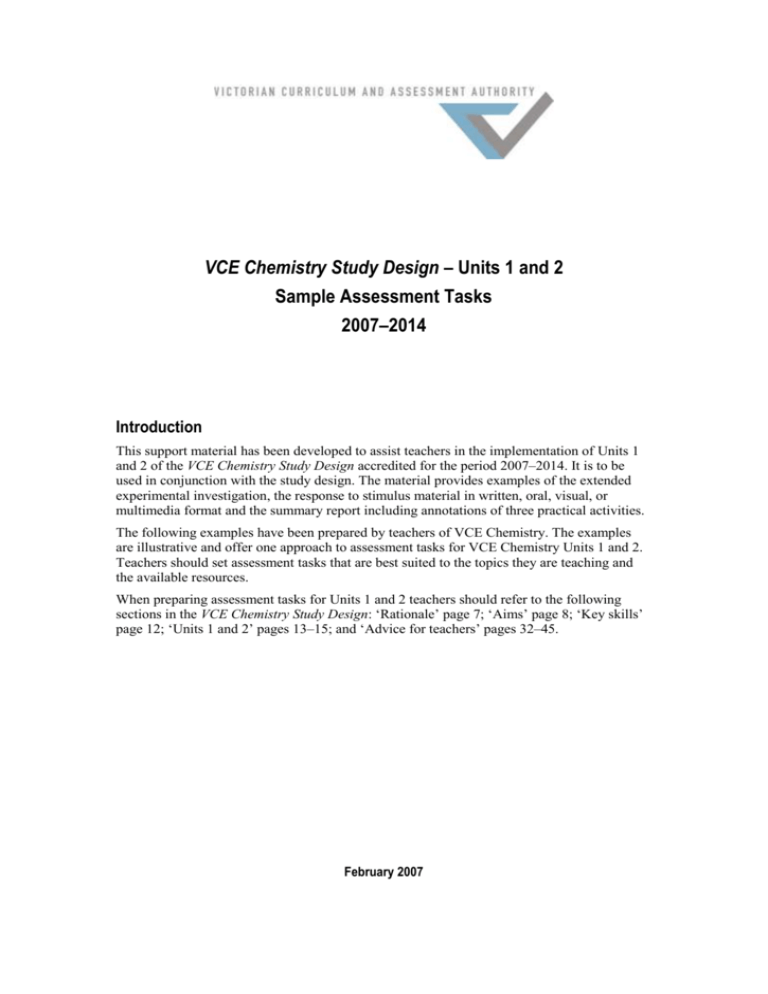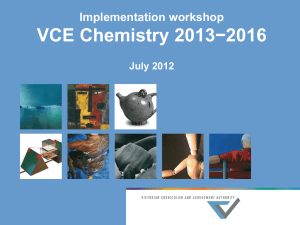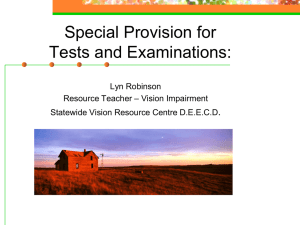Units 1 and 2 Sample Assessment Tasks 2007–2014
advertisement

VCE Chemistry Study Design – Units 1 and 2 Sample Assessment Tasks 2007–2014 Introduction This support material has been developed to assist teachers in the implementation of Units 1 and 2 of the VCE Chemistry Study Design accredited for the period 2007–2014. It is to be used in conjunction with the study design. The material provides examples of the extended experimental investigation, the response to stimulus material in written, oral, visual, or multimedia format and the summary report including annotations of three practical activities. The following examples have been prepared by teachers of VCE Chemistry. The examples are illustrative and offer one approach to assessment tasks for VCE Chemistry Units 1 and 2. Teachers should set assessment tasks that are best suited to the topics they are teaching and the available resources. When preparing assessment tasks for Units 1 and 2 teachers should refer to the following sections in the VCE Chemistry Study Design: ‘Rationale’ page 7; ‘Aims’ page 8; ‘Key skills’ page 12; ‘Units 1 and 2’ pages 13–15; and ‘Advice for teachers’ pages 32–45. February 2007 EXAMPLES OF ASSESSMENT TASKS VCE CHEMISTRY UNITS 1 AND 2 Unit 1: The big ideas of chemistry Assessment task: An extended experimental investigation The focus of this task is on the processes of science investigation: planning, designing, conducting, adjusting/amending and commenting on results and future recommendations/directions. For details of the assessment task refer to page 15 of the VCE Chemistry Study Design. Topic: What’s special (different) about transition metals? With teacher assistance and through class discussions, students (working in small groups) decide which transition metal/s they will investigate and what properties they will test. This may include an Internet search or other research. It will include a Material Safety Data Sheet (MSDS) for the metal and compounds of the metal used. Students plan how they spend the required three to five hours of laboratory/practical work, how many and which experiments they will complete and allocate time to present their research. The minimum number of experiments to be completed is agreed to by the teacher and students. Sample plan 1 hour research 1 hour to plan experiments (organise equipment, MSDS, Risk Assessment etc.) 2 hours for the experiments ½ to 1 hour for presentation Sample format Students take photos (digital or film) to record their experiments. Students assemble their photos on a poster, flowchart or in a portfolio and show: why particular properties/experiments were chosen reasons for any change made as they conducted their investigation how the results they obtained led to their response to the question any recommendations for future experiments. Although the extended experimental investigation draws on both areas of study and the set of key skills in this example it has a greater focus on Area of Study 1 and is used to demonstrate achievement of Outcome 1. AREA OF STUDY 1 Key knowledge The Periodic Table – trends and patterns of properties within The Periodic Table: atomic number, types of compounds formed, metallic/non-metallic character, chemical reactivity of elements AREA OF STUDY 2 Key knowledge models of bonding to explain observed properties including melting temperature, electrical conductivity, chemical reactivity, shape, polarity of bonds, intermolecular forces – metals limitations of bonding models VCAA February 2007 2 EXAMPLES OF ASSESSMENT TASKS VCE CHEMISTRY UNITS 1 AND 2 AREAS OF STUDY 1 AND 2 Key skills Investigate and inquire scientifically work independently and collaboratively as required to develop and apply safe and responsible work practices when completing all practical investigations including the appropriate disposal of wastes conduct investigations that include collecting, processing, recording and analysing qualitative and quantitative data; draw conclusions consistent with the question under investigation and the information collected; evaluate procedures and reliability of data construct questions (and hypotheses); plan and/or design, and conduct investigations; identify and address possible sources of uncertainty Apply chemical understandings make connections between concepts; process information; apply understandings to familiar and new contexts use first and second-hand data and evidence to demonstrate how chemical concepts and theories have developed and been modified over time Communicate chemical information and understandings interpret, explain and communicate chemical information and ideas accurately and effectively use communication methods suitable for different audiences and purposes use scientific language and conventions correctly, including chemical equations and units of measurement Assessment A possible breakdown of marks could be: work plan including Risk Assessment, MSDS choice of experiments and how relevant to the question under investigation 6 marks skills in using equipment quality and analysis of results and how these support (or otherwise) the investigation 4 marks quality of research (if relevant) quality of response to the question under investigation or the conclusion presented 4 marks comments about reliability of results and the impact on answer to question/conclusion. 4 marks future recommendation/s 2 marks VCAA February 2007 3 EXAMPLES OF ASSESSMENT TASKS VCE CHEMISTRY UNITS 1 AND 2 Assessment task: A response to stimulus material in written, oral, visual or multimedia format Students are provided with copies of ‘Nanotechnology: small science on a big scale’ from Chemistry: a pathway to the Emerging Sciences in Victoria, CD-ROM, VCAA, 2006. Although the response to stimulus material draws on both areas of study and the set of key skills in this example it has a greater focus on Area of Study 2 and is used to demonstrate achievement of Outcome 2. Written format After reading the article students answer a set of questions (provided by the teacher) or select five to six important statements or ideas included in the article and explain why they chose these particular statements or ideas. Students may need to refer to other information included on the CD-ROM. OR Multimedia format After reading the article and doing further research using the information included on the CD-ROM students use three Microsoft PowerPoint slides to provide an introduction to nanotechnology (what is it?) and its future. AREA OF STUDY 2 Key knowledge models of bonding to explain observed properties including melting temperature, electrical conductivity, chemical reactivity, shape, polarity of bonds, intermolecular forces limitations of the bonding models behaviour of surfaces and the application of surface chemistry in nanotechnology Key skills Apply chemical understandings analyse issues and implications relating to scientific and technological developments analyse and evaluate the reliability of chemistry related information and opinions presented in the public domain Communicate chemical information and understandings interpret, explain and communicate chemical information and ideas accurately and effectively use communication methods suitable for different audiences and purposes use scientific language and conventions correctly, including chemical equations and units of measurement Assessment quality and accuracy of information included reference to other sources used coherent, clearly expressed VCAA February 2007 4 EXAMPLES OF ASSESSMENT TASKS VCE CHEMISTRY UNITS 1 AND 2 Unit 2: Environmental chemistry Assessment task: A summary report including annotations of three practical activities A summary report focuses on the analysis, interpretation and evaluation of results, and articulating concepts being illustrated by the experiments. Teachers could provide students with a template to use and a set of questions to guide students with the task. For details of the assessment task refer to page 18 of the VCE Chemistry Study Design. Topic: Experiments/practical activities related to carbon dioxide Properties of carbon dioxide Reactions of carbonates Including: density pH solubility odour, taste combustion Including: acid + carbonates solubility of carbonates Laboratory preparation of carbon dioxide Small scale and/or larger (Kipps) Although this assessment task draws on both areas of study and the set of key skills in this example it has a greater focus on Area of Study 2 and is used to demonstrate achievement of Outcome 2. AREA OF STUDY 1 Key knowledge acids and bases: proton transfer; common reactions of acids; strong and weak acids and bases; polyprotic acids; amphiprotic substances redox reactions in aqueous solution including writing balanced equations for oxidation and reduction reactions, for example metal displacement reactions, corrosion of iron AREA OF STUDY 2 Key knowledge role of the atmosphere in maintaining life in the environment – chemical reactions and processes of acid rain – role of the carbon and nitrogen cycles in maintaining life on earth – the laboratory and industrial preparation of one gas of significance to the quality of the atmosphere AREAS OF STUDY 1 AND 2 Key skills Investigate and inquire scientifically work independently and collaboratively as required to develop and apply safe and responsible work practices when completing all practical investigations including the appropriate disposal of wastes conduct investigations that include collecting, processing, recording and analysing qualitative and quantitative data; draw conclusions consistent with the question under investigation and the information collected; evaluate procedures and reliability of data apply ethics of scientific research when conducting and reporting on investigations VCAA February 2007 5 EXAMPLES OF ASSESSMENT TASKS VCE CHEMISTRY UNITS 1 AND 2 Apply chemical understandings make connections between concepts; process information; apply understandings to familiar and new contexts use first and second-hand data and evidence to demonstrate how chemical concepts and theories have developed and been modified over time analyse issues and implications relating to scientific and technological developments analyse and evaluate the reliability of chemistry related information and opinions presented in the public domain Communicate chemical information and understandings interpret, explain and communicate chemical information and ideas accurately and effectively use communication methods suitable for different audiences and purposes use scientific language and conventions correctly, including chemical equations and units of measurement Possible formats (selected by teacher and/or students) for the summary report 1. Students use their results to produce a profile for carbon dioxide using a table (see below) or a concept map. 2. Students use their results to explain what happens in during the carbon cycle. 3. Students use their results to explain why carbon dioxide is a labelled a ‘greenhouse gas’. 4. Students use their results to complete a set of questions where the answers become the annotations. Profile of carbon dioxide Students complete a results table for each experiment which can be submitted with the summary report. Annotations (words and equations as appropriate) Summary of results Property Application Experiment 1 Dense, stable, colourless, odourless Extinguish fires as it prevents (smothers) oxygen reaching the flames CO2 heavier than air, not combustible, product of combustion, slightly acidic Breathing into a paper bag to assist a person who is hyperventilating Assists to sustain life on earth Yes No – if inhaled it can lead to loss of consciousness and death in a house fire Yes – as it restores the balance between air inside and outside lungs and helps the person calm down Yes – helps pearl divers so that they don’t need scuba gear to collect the pearls VCAA February 2007 6 EXAMPLES OF ASSESSMENT TASKS Combining Experiments 1 and 2 Combining Experiments 2 and 3 Tasteless and low solubility (increases as T decreases) Low pH and produces weakly acidic solution (‘acid rain’) VCE CHEMISTRY UNITS 1 AND 2 Carbonic acid solutions can be used as mild disinfectant Yes – as an environmentally friendly solution Provides the ‘pop’ in cold soft drinks Yes – as soft drinks taste great and are not dangerous like alcohol Photosynthesis Ensures aquatic plants survive (and oxygen produced used by aquatic animals) Damage to buildings, bridges made from iron, marble statues, plants, limestone No – causes structural damage that cost money to repair High solubility of carbonates in acids Yes – rivers containing carbon dioxide flowing through causes limestone areas produces caves (homes for animals and tourist attractions) In conclusion (3 short sentences) Carbon dioxide is essential to sustaining life on Earth because … However … Assessment A possible breakdown of marks could be: completion of results tables/sheets 4 marks identification of links between the three experiments 4 marks clear links between results, properties and applications 4 marks annotations relevant to sustaining life on earth 4 marks conclusion brings all aspects together in a coherent paragraph 4 marks Other examples of formats Carbon cycle Students use their results to complete boxes in a supplied diagram of the carbon cycle and complete the following statement (three short sentences). Carbon dioxide is essential to sustaining life on Earth because of its role in the carbon cycle where … Carbon dioxide is a green house gas Students use their results to build a flowchart showing how carbon dioxide enters the atmosphere and what it does once in the atmosphere. VCAA February 2007 7 EXAMPLES OF ASSESSMENT TASKS VCE CHEMISTRY UNITS 1 AND 2 Further examples of possible assessment tasks Unit 1: The big ideas of chemistry • Extended experimental investigation of making particular polymers, their structures and uses. • A summary report including annotations of three practical activities that show relationships between concepts. A flow chart showing how to use experimental data, to calculate mass number, isotopes, relative atomic mass, empirical and molecular formula and the mole could be included. Unit 2: Environmental chemistry • Extended experimental investigation of the corrosion of iron or purification of water or solubility of substances in water. • A summary report including annotations of three practical activities that show how acid (base) strength and concentration are determined, the relationship between strength and properties/uses of acids and bases and the role of acids in redox equations. VCAA February 2007 8










